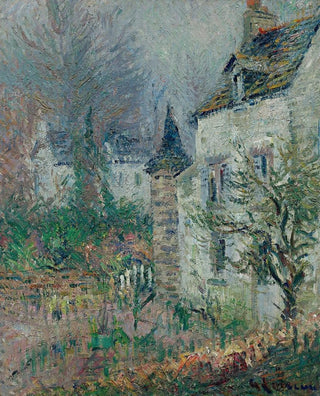Art print | La Maison du Juge Pont-Aven - Gustave Loiseau


View from behind

Frame (optional)
Reproduction La Maison du Juge Pont-Aven - Gustave Loiseau – Captivating introduction
In the vibrant universe of art, some works stand out for their ability to capture the essence of a place and a time. "The Judge's House Pont-Aven" by Gustave Loiseau is one of those creations that transcends mere landscape to become a vivid testimony of Breton life. Through this piece, the artist invites us to enter a world where light, colors, and shapes intertwine to evoke an atmosphere that is both peaceful and mysterious. The house, which stands proudly at the center of the painting, becomes a symbol of local tradition, while also evoking the timeless beauty of the surrounding nature.
Style and uniqueness of the work
Loiseau, an emblematic figure of the Post-Impressionist movement, is distinguished by his unique approach to color and light. In "The Judge's House Pont-Aven," he uses a rich and vibrant palette, where shades of green, blue, and ochre blend harmoniously to create a composition that is both dynamic and soothing. The brushstrokes, precise yet fluid, bring life to the landscape elements, whether it be majestic trees or floating clouds in the sky. This painting does not merely depict a place; it evokes a sensation, an emotion, almost tangible. The house, far more than a simple building, becomes a character in its own right, anchoring the viewer in a reality that is both familiar and distant.
The artist and his influence
Gustave Loiseau, born in 1865, established himself as one of the masters of Breton landscape painting. His work is marked by a fascination with light and climatic variations that transform the scenery. Influenced by the great masters of Impressionism, Loiseau develops a style that is uniquely his own, combining the rigor of drawing with the freedom of color. Through his paintings, he manages to convey a unique atmosphere, at the crossroads between reality and imagination. His ability to capture the ephemeral, to immortalize fleeting moments, makes him an essential artist of the early 20th century.

Matte finish

View from behind

Frame (optional)
Reproduction La Maison du Juge Pont-Aven - Gustave Loiseau – Captivating introduction
In the vibrant universe of art, some works stand out for their ability to capture the essence of a place and a time. "The Judge's House Pont-Aven" by Gustave Loiseau is one of those creations that transcends mere landscape to become a vivid testimony of Breton life. Through this piece, the artist invites us to enter a world where light, colors, and shapes intertwine to evoke an atmosphere that is both peaceful and mysterious. The house, which stands proudly at the center of the painting, becomes a symbol of local tradition, while also evoking the timeless beauty of the surrounding nature.
Style and uniqueness of the work
Loiseau, an emblematic figure of the Post-Impressionist movement, is distinguished by his unique approach to color and light. In "The Judge's House Pont-Aven," he uses a rich and vibrant palette, where shades of green, blue, and ochre blend harmoniously to create a composition that is both dynamic and soothing. The brushstrokes, precise yet fluid, bring life to the landscape elements, whether it be majestic trees or floating clouds in the sky. This painting does not merely depict a place; it evokes a sensation, an emotion, almost tangible. The house, far more than a simple building, becomes a character in its own right, anchoring the viewer in a reality that is both familiar and distant.
The artist and his influence
Gustave Loiseau, born in 1865, established himself as one of the masters of Breton landscape painting. His work is marked by a fascination with light and climatic variations that transform the scenery. Influenced by the great masters of Impressionism, Loiseau develops a style that is uniquely his own, combining the rigor of drawing with the freedom of color. Through his paintings, he manages to convey a unique atmosphere, at the crossroads between reality and imagination. His ability to capture the ephemeral, to immortalize fleeting moments, makes him an essential artist of the early 20th century.






